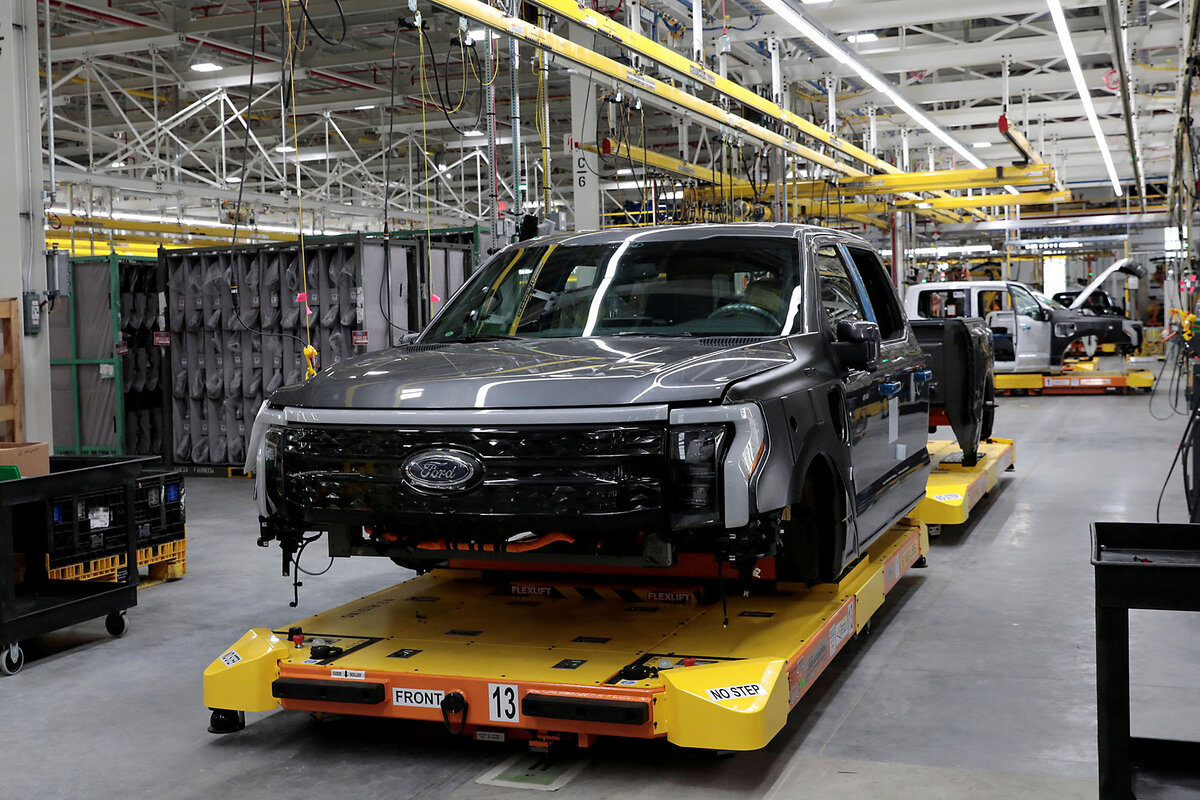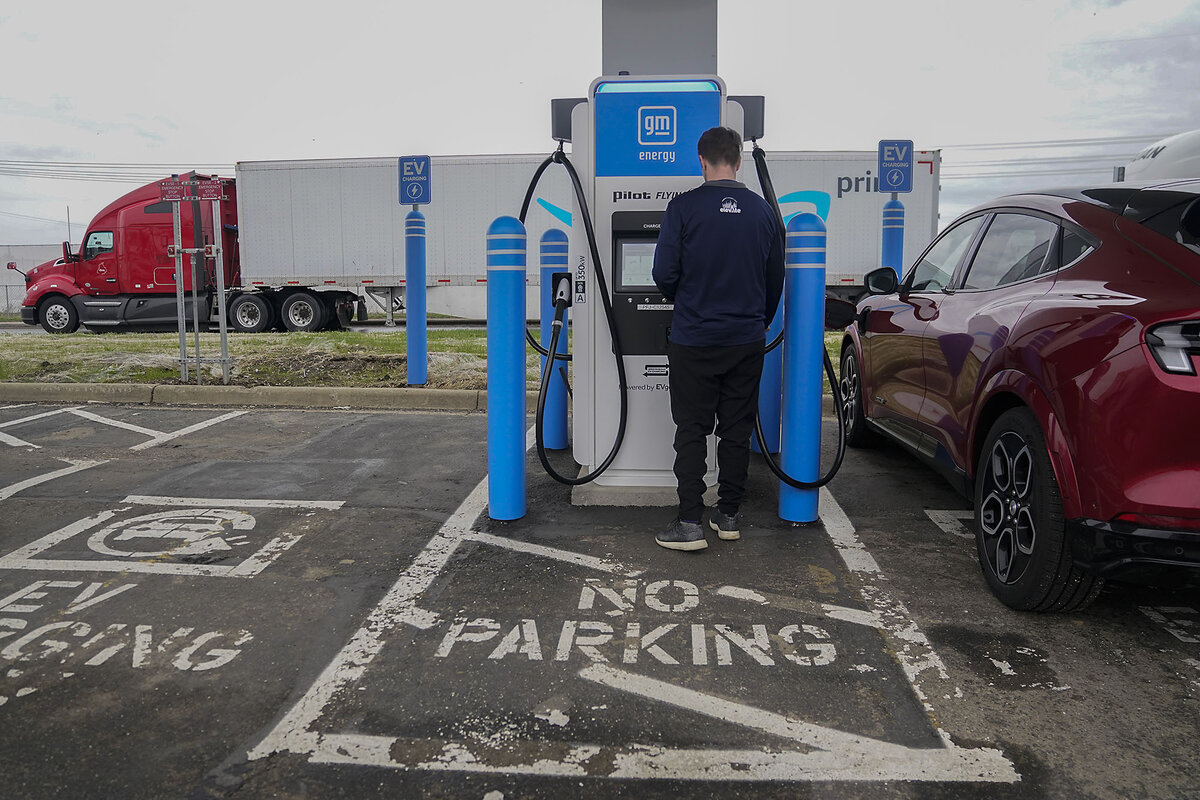Tesla news looks grim. But the bigger picture for EVs is a bright one.
Loading...
Given recent headlines, one might be excused for thinking electric vehicles are in trouble.
From reports about Ford’s financial losses on its much-hyped electric F-150, to questions about the real eco-friendliness of EVs, to recent news of Tesla’s mass layoffs and questions about its supercharger program, the take-away seems to be that the electric revolution is stalling.
But it’s not.
Why We Wrote This
A story focused onRecent news suggests the shift to electric vehicles is hitting roadblocks. Behind the headlines, evidence points to an industry continuing to grow and innovate.
The reality is that EV sales are growing rapidly, the technology is evolving briskly, and everyone from policymakers to auto executives to consumers is putting EVs at the center of long-term planning. Experts say a transition from a transportation sector based on the internal combustion engine to one that is electrified is all but inevitable.
“The trajectory is clear,” says Gernot Wagner, a climate economist at Columbia Business School. “None of this is ‘if’; it is ‘when.’”
According to a new report from the International Energy Agency (IEA), the first quarter of 2024 saw a 25% growth in global EV sales over the same time period in 2023. That may be slower than the year before, and the slowdown was sharper still in the United States, but the overall pace is still impressive, experts say, and expected to continue.
“It’s not like automakers are saying, ‘Oh, we’re going to go back to internal combustion engine vehicles,’” says Joel Jaeger, senior research associate for the World Resources Institute’s systems change lab and climate program. “They’re just taking a little longer to get to their EV plans.”
But how much longer, and how that transition takes shape, has a slew of implications for American workers, international trade, domestic policies – and the Earth’s climate. The spate of recent negative news points to the difficulties inherent in making a complicated shift to a still-developing technology.
Heading toward an EV mass market
The transportation sector is the largest source of direct greenhouse gas emissions in the U.S., according to the Environmental Protection Agency. That’s largely from gasoline exhaust. But some critics point out that emissions also occur in car manufacturing, including for EVs, and there are negative environmental impacts from lithium and rare-earth mineral mining. Still, despite increasing questions about the green credentials of EVs, multiple studies show that over their life spans, EVs have a lower climate impact than fossil fuel-based cars.
“You’ll still have some remaining emissions,” says Sergey Paltsev, a senior research scientist at the Massachusetts Institute of Technology who is deputy director of the MIT Joint Program on the Science and Policy of Global Change. “You need to mine the elements. You need to transport them. You need to produce a battery, you need to produce a car, and you need to also transport that car. ... Still, if you compare the overall emissions in the life cycle of an internal combustion vehicle to an electric vehicle, it’s clear that electric vehicles are better.”
The difference becomes even starker when a consumer uses renewable energy sources for electricity, he says.
But how quickly Americans will embrace this cleaner tech is unknown. Mr. Jaeger says the American EV market seems to be following an “S-curve” typical of many new technologies. Early adopters rush to buy the cool new thing at a high cost, sales growth slows until manufacturers can produce the technology more efficiently, and then the mass market begins to purchase the item and sales increase again.
That mass market adoption has already started in China, which in many ways has had a head start on EVs, investing years ago in battery plants, charging networks, and EV subsidies. More than 40% of Chinese car purchases in 2024 will be electric, according to the IEA. (In the U.S., the group projects, that number is 11%, and it’s 25% in Europe.)
Part of this is because of cost, analysts say. Chinese automaker BYD, which temporarily passed Tesla as the global leader in EV manufacturing last year, offers electric models for less than $15,000. (Tesla CEO Elon Musk has announced that the company will have its own, lower-priced EV by 2025.) There are also far more charging networks in China. Using World Bank population data and IEA charging infrastructure data, Mr. Jaeger calculates that as of 2023, China had 191 public charging stations per 100,000 people, compared with 55 public chargers per 100,000 people in the U.S.
Charging networks: Federal dollars are flowing
Cost and range anxiety are two of the most-cited reasons that Americans shy away from EVs.
But Ingrid Malmgren, senior policy director for Plug In America, an EV advocacy nonprofit, says both of these challenges will lessen in coming years. The $7.5 billion allocated by Congress in 2021 for charging stations is starting to bear fruit, she says. The money has been distributed to the states, which are in turn starting to build out charging networks, which promises to reduce consumer worries about getting stuck with a depleted battery pack.
“Like any big infrastructure project, it’s just a slow process,” she says. “There’s a lot of groundwork that had to be laid. I expect for it to be ramped up from here.”
Indeed, the number of public chargers increased in the U.S. 43% between 2022 and 2023, according to the IEA. But they are unevenly spaced around the country, and drivers are still wary of charge times.
Over the past half-year or so, most automakers have announced that their cars will be compatible with the Tesla supercharging system, now called the North American Charging Standard, which was originally only for Tesla vehicles. The move paves the way for more universal and faster charging, analysts say – although many are also wondering about the impact of Mr. Musk’s recent decision to lay off most of the team dedicated to making those superchargers. The Tesla CEO hasn’t publicly explained his move, but has said he was going to go “hard core” on staffing to balance lower sales numbers.
Meanwhile, there is continued work on both motor and battery technology, says Matthias Priendl, associate professor of power electronic systems at Columbia University. Research teams across the country are devoted to reducing or eliminating some of the rare-earth minerals currently used in battery production, and to developing motor technology that will continue to expand the range of EVs.
“The exciting thing about electric vehicles is that we’re still at the early stages of mass production and scaling up,” he says.
Risks if carmakers pivot too quickly – or too slowly
But that early stage has left American automakers with a challenge. They can push to quickly scale up EV production with current technology and risk getting ahead of supply chains and consumers. Or they can make a slower transition, with the hope of a more streamlined process in the future, but delay the cost benefits of large-scale production and risk losing customers to Chinese competitors.
“It’s a really important moment right now for the automakers,” says Ian Greer, a research professor at Cornell University’s School of Industrial and Labor Relations. “And they don’t have much time to figure this out before their competitors find strategies that work to mass-produce EVs for North America and European markets.”
The fear of a rapid transition goes beyond profits. Existing autoworkers in internal combustion engine plants worry about losing jobs – and Congress has not acted to protect workers, says Dr. Greer.
Meanwhile, some Americans worry that the federal government is going to ban their gas-powered trucks and cars – a concern seized upon and repeated by some politicians even though experts see no such move occurring. (Indeed, even if automakers rapidly transitioned to EVs, the existing gas-powered fleet would stay on the road for years, if not decades, Mr. Jaeger points out.)
The real mindset shift may come as more Americans drive EVs themselves, Ms. Malmgren says – something she sees happening as more people give electric cars a test drive.
After she leased her first EV, she never went back, and not just for the environmental reasons.
“The technology, the efficiency, the performance – there’s just no comparison,” she says. “I think change is a little messy sometimes. And it can be a little scary for people. But it can end up being wonderful.”









